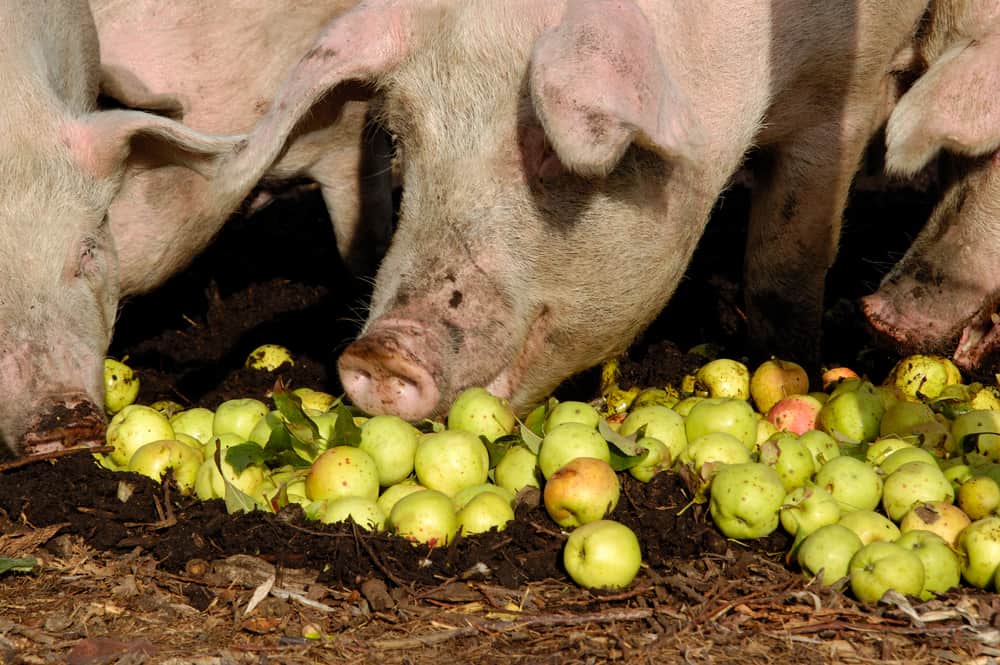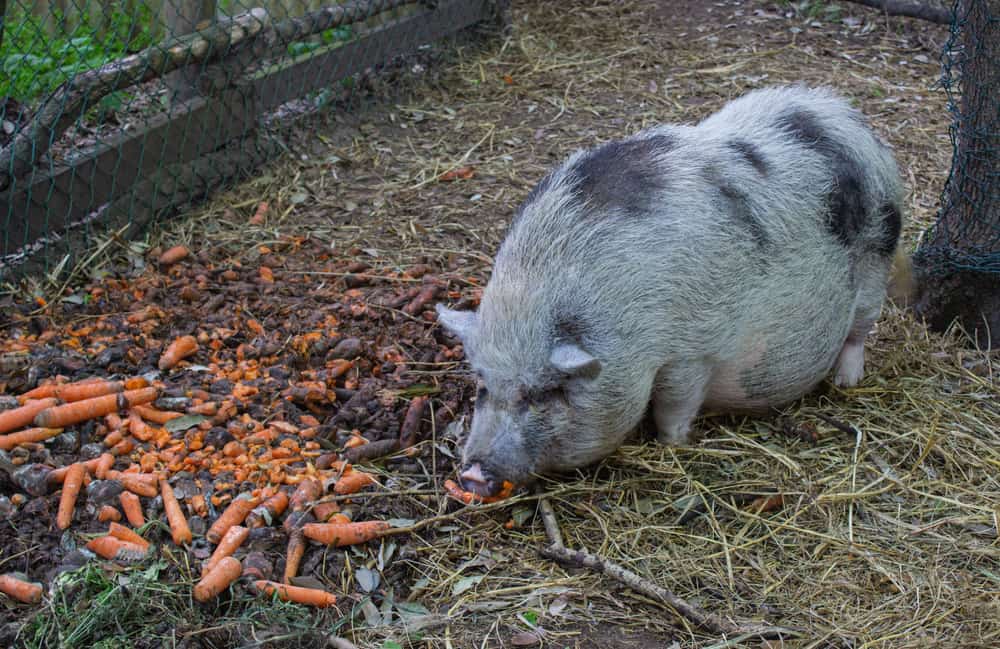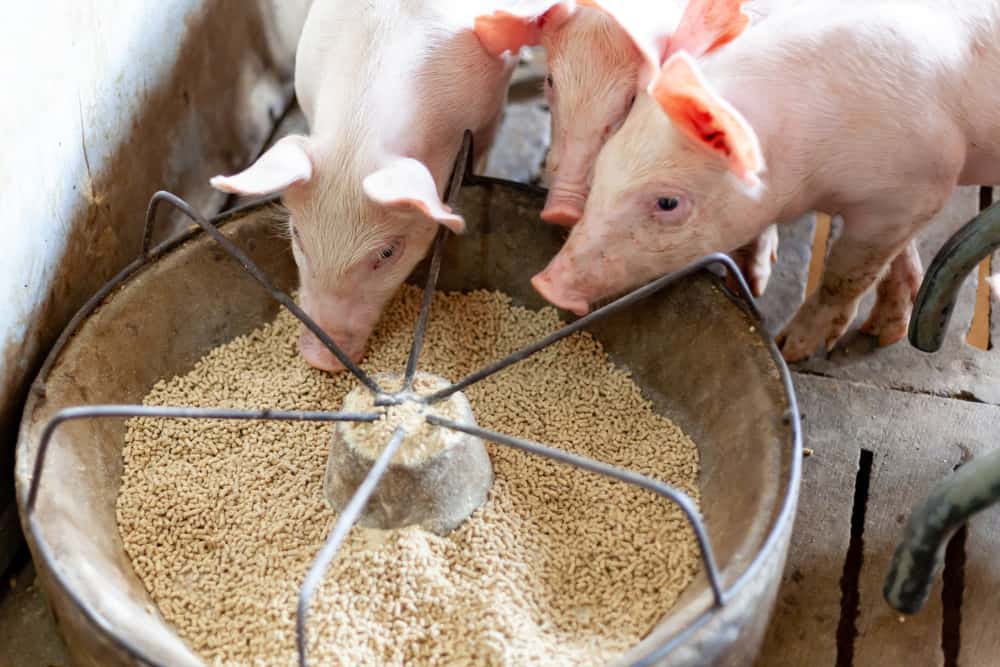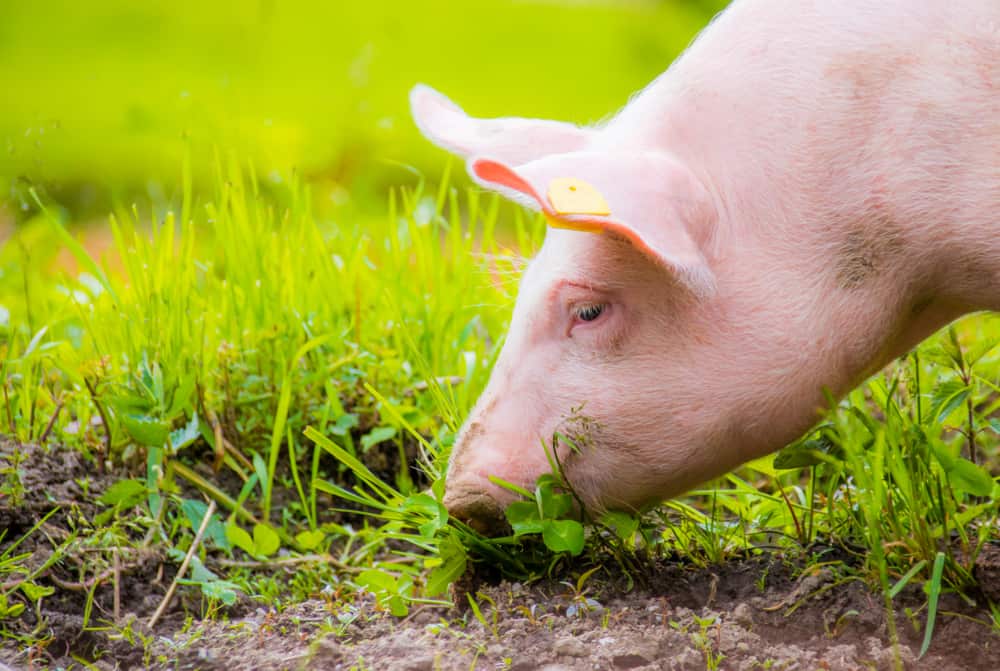Nowadays, the profitability of swine production directly depends on the correct feeding. Contrary to popular belief that pigs will thrive by eating waste food, these omnivores require a high-energy diet packed with proteins and low in fiber to become healthy and prosperous. Pigs can adapt eating habits to any food, but the question is, what do pigs eat when they can choose.
Pigs Habits and Biology
Pigs are omnivorous, meaning they eat both plants and animals. These animals belong to the Sus genus that consists of a few pig species, including:
- Domestic pig (Sus domesticus)
- Wild boar (Sus scrofa)
- Bornean bearded pig (Sus barbatus)
- Palawan bearded pig (Sus ahoenobarbus)
- Javan warty pig (Sus verrucosus)
- Visayan warty pig (Sus cebifrons)
- Celebes warty pig or Sulawesi warty pig (Sus celebensis)
- Philippine warty pig (Sus philippensis)
- Oliver’s (Mindoro) warty pig (Sus oliveri)
Historians believe that these animals were domesticated in China and India earlier, but you can only find evidence that pigs became domestic animals 10,000 years ago in Turkey. It seems they became a part of human households just after dogs.
Pig types |
|
| Scientific classification | Pig |
| Kingdom | Animalia |
| Phylum | Chordata |
| Class | Mammalia |
| Order | Artiodactyla |
| Family | Suidae |
| Subfamily | Suinae |
| Genus | Sus |
It is assumed that the European domestic pigs’ ancestors were Eurasian wild boars. Surprisingly, they didn’t live in Australia and the Americas. After Columbus’ second voyage, pigs came to the New World and quickly adapted to the new conditions of life.
These animals have only one stomach and impressive snouts capable of unbelievable muscle control. While nerves in humans directly connect the brain with hands, they link pigs’ brains with touch-sensitive snouts.
Do Pigs Eat Dirt?
Contrary to popular belief, pigs don’t eat mud. They sometimes dig in the mud while looking for soft tubers, not dirt. Keep in mind that these animals need clag since wallowing in it is a way to regulate their body temperature and keep their bodies cool.
On the other hand, they often consume their poop, mainly when hungry or their meal doesn’t contain the necessary nutrients. Another reason is one more possibility to digest the undigested nutrients from the previous try.
What Do Pigs Like to Eat Most
It is estimated that pig domestication started in 6,000 BC, but some species still live in the wild. Regardless of the place of residence, they have one thing in common. All of them eat everything in their path without too much picking.
However, domesticated pigs need a well-balanced diet that contains:
- Grass
- Flowers and leaves
- Roots
- Fruits and berries
- Vegetables, turnips, and legumes
- Mushrooms
- Tree barks
Feeding pigs on farms is strictly under control, and many farmers consult nutritionists to make the right combination of ingredients and get the best pig growth rates.
The only way for pigs to reach desired weight quickly is to feed them with:
- A concentrated grain diet low in fiber that includes wheat, corn, barley, and oats
- Soybean
- Alfalfa
- Hay
On the other hand, wild pigs prefer:
Sadly, it is not rare for a mother pig to eat its offspring when hungry and without food nearby.
Pig food requirements will change over time. You can recognize three growing stages:
- Piglets weighing under 40 pounds (18 kg)
- Growing pigs weighing 40 to 125 pounds (18 – 57 kg)
- Finishing pigs weighing from 125 pounds to market weight of at least 230 pounds (57 – 105 kg)
The best option is to let newborn piglets intake mom’s milk. After a week, you can offer them a small amount of solid food. If milk is not available, young piglets eat creep feed with milk proteins.
You can also provide a pre-starter feed. This grains and milk protein mix is an excellent option for piglets under 15 pounds (7 kg). As soon as piglets stop drinking milk, it is time to introduce starter feed that includes:
- Soybean
- Sorghum
- Peanuts
- Sunflower seeds
This mix is a win-win combination for fast growth, and you can offer it to piglets until they reach 45 pounds (20.5 kg).
Growing and finishing pigs need enough energy and proteins, so you need to offer them:
Corn – Since this food is high in carbs, it is an affordable energy source for farm pigs.
Soybean – It is necessary food for pigs because of its high protein levels and a decent amount of necessary fats and carbs.
Grains – Farm-grain-based ingredients include wheat, oats, barley, and sorghum, which provide essential amino acids no other pig food contains.
There is one more thing! Pigs require lots of fresh, clean water to get desired growth rate fast. Be aware that newly weaned pigs are prone to dehydration, so you should provide readily accessible drinking water throughout the day.
Food Avoid to Feed Pigs
Many food types can be toxic to pigs, including:
Mycotoxins – These natural toxins from molds are the most common reason for pig poisoning.
Meat, fish, and milk – These food types often contain harbor viruses that jeopardize pigs’ health.
Raw eggs – Feeding pigs with them will often disturb regular biotin absorption. On the other hand, cooked eggs have no negative impact on this water-soluble vitamin absorption.
Alcohol – If you feed your pigs with brewing waste, you can cause alcohol poisoning due to prolonged grain fermenting.
Salt – Growing pigs don’t need much salt but can tolerate up to 8% of this ingredient in the food. Keep in mind that it is 40 times higher level than required.
In most cases, wet meals contain high levels of salt that can be toxic to pigs in the long run. Plus, salt poisoning causes dehydration and additional problems it can bring.
Sugar – Food with high sugar levels will slow pig growth rates.
Medications – Excessive medication use is often a considerable poison risk for pigs, so you shouldn’t offer any drug without consultation with your vet.
Coal tar – Many paints and disinfectants contain this chemical. Pigs like its taste, but its ingestion will lead to liver damage and even fatal outcome.
There is a list of plants that are highly poisonous to pigs, such as:
- Yew, ivy, laurel, laburnum, and elder
- Bracken
- Lily of the valley, buttercup, rhododendron, arum lilly, periwinkle, and deadly nightshade
- Hemlock, henbane, ragwort, and foxglove
- Weeds like spurge, jimsonweed, bindweed, Jamestown weed, pricklyburr, and stinkweed
- Daffodils, hyacinths, tulips, and scillas bulbs
- Cocklebur and unripe acorns
Pigs also shouldn’t consume:
- Cabbage, mustard, and broccoli roots and seeds
- Apple seeds
- Rhubarb and young oak leaves
- Tomato leaves and vine
- Avocado skin and pit
- Potatoes leaves, stems, and green tubers
- Cherry, pears, apples, apricot, and plums trees’ leaves
- Parsnip
It is harmful, plus illegal in many countries to feed pigs with:
- Kitchen scraps
- Used cooking oil
- Mammals carcasses, offal, bones, and blood
- Processed food
- Processed leftovers from supermarkets, restaurants, hotels, bakeries, cafes, lunch bars, delicatessens, and fast food outlets
- Food from rubbish dumps
Tips to Feed Pigs
Pigs gain approximately 1.5 to 1.7 pounds (680 – 771 g) a day until reaching 110 pounds (50 kg) and up to 2 pounds (907 g) when they become mature. Farm pigs consume 6 to 8 pounds (2.7 – 3.6 kg) of food a day. Growing and finishing pigs can eat about 5% of their body weight on average.
A common misconception is that a pig doesn’t mind eating anything. This animal will enjoy consuming corn, grains, and soybeans but avoid rotten, moldy, and slimy food. Nowadays, you can even find pig feed rations.
It is crucial to modify pigs’ diet and their lifestyle. For instance, you won’t feed the pet pig the same way as animals for fattening.
On the other hand, many farmers practice organic farming and let their pigs graze on fresh grass. Pigs with access to a pasture will need a lower amount of grains. Most people don’t know that pigs enjoy eating hay. This food type improves the meat taste and increases omega-3 fatty acids levels.
Farmers often provide supplements to their pigs as an excellent option to add necessary vitamins and minerals to their diet. That way, it is possible to make up for any potential nutritional deficiencies. In most cases, pigs need an extra amount of crucial minerals, including:
- Sodium
- Calcium
- Chloride
- Zinc
- Selenium
- Copper
- Iron
- Iodine
You can improve pigs’ digestion by offering them expired cheese and milk.
Sows in gestating or lactating constantly require food with higher nutrient levels and more water and lysine supplements.
Feeder system
The feeder system is a convenient but entirely unhealthy option at farms. Once you add food, pigs will eat the amount they need, and the rest will stay for hours and often spoil. Plus, it will attract rodents and bugs, making it potentially dangerous.
A better solution is to establish feeding twice a day and offer food on a dry piece of land. As a result, you will spend less food, reduce waste, and get higher growth rates.
Summary
If you want to grow healthy meat pigs, you should feed them with a balanced combination of corn, grains, and soybean. Always provide food rich in protein to let pigs synthesize necessary amino acids. Remember that an inadequate diet will often cause irritation and even some diseases in pigs in the long run.



